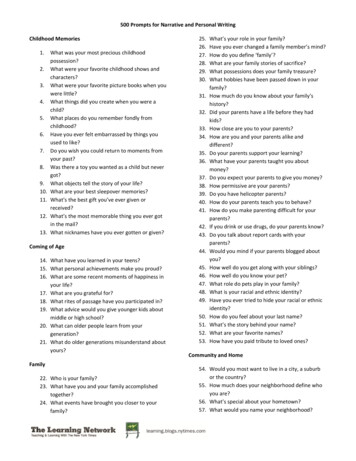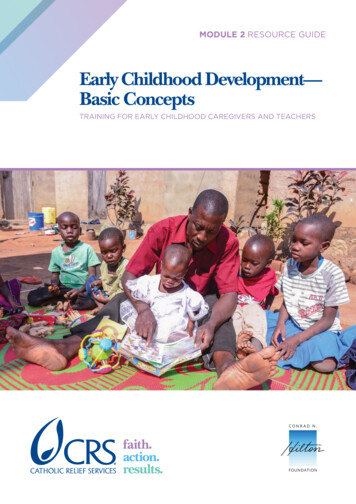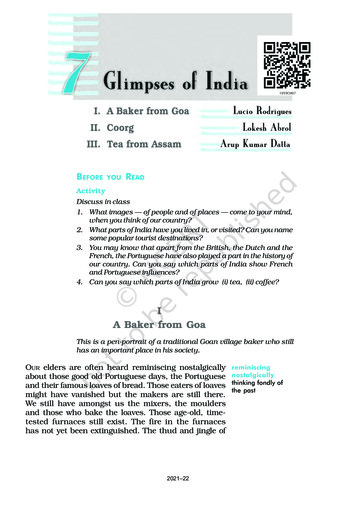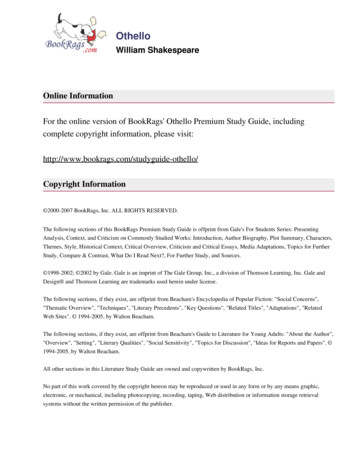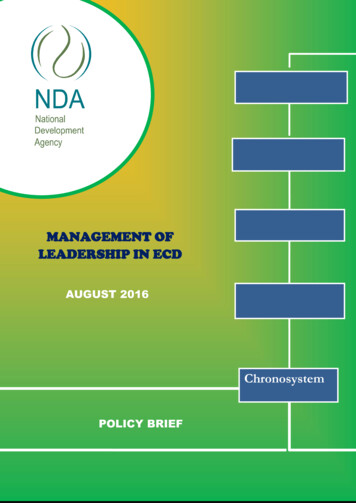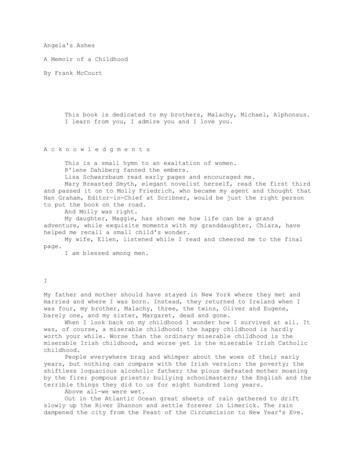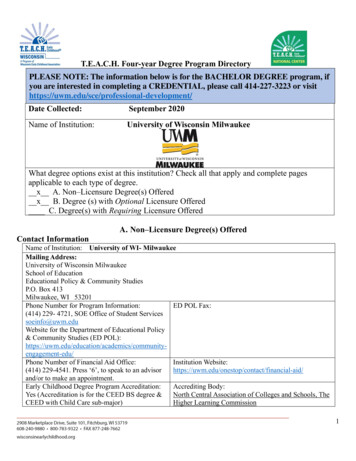
Transcription
ISSN 1799-2591Theory and Practice in Language Studies, Vol. 10, No. 7, pp. 785-790, July 2020DOI: http://dx.doi.org/10.17507/tpls.1007.09Who has Stolen Their Childhood?—AComparative Study Between The Book Thief andGrave of the Fireflies from the Perspective ofTrauma NarrativesManli PengUniversity of Shanghai for Science and Technology, Shanghai, ChinaYan HuaUniversity of Shanghai for Science and Technology, Shanghai, ChinaAbstract—Literature from the perspective of perpetrators receives less attention due to history and ethicalproblems, but it is our duty to view history as a whole. By comparing and analyzing The Book Thief and Graveof the Fireflies, this study claims that war and blind patriotism have stolen the childhood from thewar-stricken children and that love, care, company and chances to speak out the pain can be the treatments.In the study, traumatic narratives, traumatic elements and treatments in both books are discussedcomparatively and respectively.Index Terms—The Book Thief, Grave of the Fireflies, traumatic narratives, traumatic elements, treatmentsI. INTRODUCTIONMarkus Zusak's novel The Book Thief relates how Liesel Meminger, a little German girl, lost her beloved ones duringthe Second World War and how she overcame her miseries with love, friendship and the power of words. But The BookThief is not just a Bildungsroman. According to Zusak, the inspiration of the book came from his parents, whowitnessed a collection of Jews on their way to the death camps and the streetscape of Hamburg after the firebombing.The story “depicts the traumatic life experience of the German civilians and the hiding life of a Jew in the harshsituation of racial discrimination”(Chen, 2016, p. 9). Therefore, by describing what ordinary Germans’ life was in theSecond World War, Zusak offers us a new perspective of the war. Thereby, since the publication of The Book Thief in2005, it has turned out to be a great success. Its film adaption, released in 2013, also won high praise.Grave of the Fireflies, published in 1968, is a semi-autobiographical story written by Akiyuki Nosaka in 1967. Thestory was constructed from his experiences of the firebombing of Kobe in 1945, during which time he lost one of hissisters, his adoptive father and his younger adoptive sister Keiko. He felt especially sorry for Keiko because he thoughthe was too selfish to take good care of her, which indirectly led to her miserable death of malnutrition. In Grave of theFireflies, four-year-old Setsuko, the younger sister of the protagonist Seita, also dies of malnutrition. Thus, the wholestory “was written as a personal apology to Keiko, regarding her death”(Wikipedia, Grave of the Fireflies). By tellingtraumatic experiences of the two Japanese children in the Second World War, Nosaka reveals the brutality of war andthe deteriorating public morals of Japan during the wartime. Grave of the Fireflies earned him the Naoki Prize in 1968and was successfully adapted into an animated film in 1988 followed by a live action television film.II. LITERATURE REVIEWBoth The Book Thief and Grave of the Fireflies set their backgrounds in the Second World War, but what arouses ourinterest is that the stories they relate offer us a new perspective different from that of the dominant group — the victimsof the war. As we all know, Germany and Japan were perpetrators in the Second World War but children from thosecountries were a special group because they were innocent, and they had nothing to do with the war, but it is they whousually paid the price of their life. Even though they did not have to go to the war front, they suffered or died fromillness or weakness due to lack of care. However, in light of the mainstream thinking of history and ethical problems,we do not have sufficient literature or related researches from or about countries of perpetrators. That causes aproblem— we do not have a comprehensive view of the history. Nevertheless, if we do not view history or traumaholistically, it will “potentially prevent us from understanding our collective consciousness and may cause the dividebetween the descendants of both victims and perpetrators across further generations”(Burakova, 2018, p.2). Nowadays,the literature of war receives an increasing attention, even if, paradoxically, there is just a small amount of studies onthe two books -- The Book Thief and Grave of the Fireflies. 2020 ACADEMY PUBLICATION
786THEORY AND PRACTICE IN LANGUAGE STUDIESGenerally speaking, researchers of The Book Thief abroad agree to classify it as holocaust literature, yet it is popularto redefine the book’s genre. For example, Evelyn Arizpe and Vivienne Smith regard The Book Thief as children’sliterature in their book Children as Readers in Children's Literature. Some researchers turn to theory of narratology orpsychology to analyze the book, such as Débora Almeida de Oliveira’s The Deadly Perception of the Witness:Focalization in Markus Zusak’s The Book Thief and Rizka Merdifa’s The Main Character’s Loss, Emptiness and Objectof Desire in Markus Zusak’s The Book Thief. While some, like Morgan Grace Milburn, make comparative studies aboutthe book. Milburn discusses dystopia in The Good, the Bad and the Useless: The Perception of Books in RayBradbury’s Fahrenheit 451, Markus Zusak’s The Book Thief, and Gary Shteyngart’ s Super Sad True Love Story.Domestically, there are few researchers studying this contemporary novel, and in most of the cases, they analyze thebook with a specific literary theory such as psychological analysis, theory of narratology and symbolism, taking ZhangRongxin’s Trauma and Recovery in The Book Thief, Xing Fangfang’s A Study of the Protagonist Liesel’s Initiation inThe Book Thief by Markus Zusak from Genette’s Narrative Focalization Theory and Chen Huan’s A Study of theTrauma Narrative in The Book Thief as an example.Studies of Grave of the Fireflies are even less, even though its film adaption receives more attention than the bookitself abroad or at home. For instance, Alistair Swale makes a comparative study between two films in Memory andForgetting: Examining the Treatment of Traumatic Historical Memory in Grave of the Fireflies and The Wind Rises andDavid C. Stahl discusses trauma in the film of Grave of the Fireflies in his book Imaging the War in Japan. In China,researchers study symbols and values of life reflected in this story. However, researches directly related to the book areobviously deficient.The Book Thief and Grave of the Fireflies, as war literature, should have aroused more academic interest respectively.As for putting them together for a comparative study, the present essay might be a first tentative venture aiming atcomparing the two literary works from the perspective of perpetrators to find their similarities as well as differences.This paper, based on trauma narratives, dives deep into the two books to find out how war could steal the children’schildhood, to what degree children in war from Germany and Japan shared similarities and differences and how theyease their traumatic memory of the victims. By studying literature from the perspective of perpetrators, we can have aclear and comprehensive knowledge about the war and history.III. TRAUMA NARRATIVES IN THE BOOK THIEF AND GRAVE OF THE FIREFLIESAs it has been mentioned above, The Book Thief and Grave of the Fireflies set their backdrop in World War Ⅱ,which has laid the gloomy foundation of the story. The way Zusak and Nosaka related the story is no other than traumanarratives.“. if her mother loved her, why leave her on someone else’s doorstep? Why? Why? Why? The fact that she knewthe answer — if only at the most basic level — seemed beside the point. Her mother was constantly sick and there wasnever any money to fix her. Liesel knew that. But that didn’t mean she had to accept it. No matter how many times shewas told that she was loved, there was no recognition that the proof was in the abandonment. Nothing changed the factthat she was a lost, skinny child in another foreign place, with more foreign people. Alone. ”(Zusak, p. 32)This is a description of the inner world of Liesel when she was left by her mother to a foster family. She felt so hurteven though she knew it was for her good sake. Actually, her young brother was supposed to go to the new family withher but died on the half way. The episode is heartbreaking because it reveals not only how vulnerable and helplesschildren were but also the wretched status people got stuck in during the wartime. Especially for the poor, even if luckyenough to be less touched by war, their situation could get worse due to economic stagnation. For Liesel, she wasabandoned just because her mother could not afford to take care of the siblings. The death of her brother and theabandonment of her mother came as a double blow and induced her post-traumatic stress disorder (PTSD), whichtortured her for a long time.Etymologically, trauma means a wound, a hurt or a defeat, and it is a term especially referring to a physical wound inmedicine. However, with the development of psychology, researchers found the connection between people’s abnormalbehaviors and their traumatic experiences. Thus, trauma also refers to a psychic wound caused by an unpleasantexperience and its followed abnormal stress. For Liesel, her physical trauma could be starving all the time and a healthychild doesn’t look “skinny and pale” (Zusak, p. 24). Whereas, compared to her mental trauma, starvation was moretolerable. Since Liesel witnessed her brother’s death, she was haunted by PTSD and had nightmare every night wakingup screaming and sweating. PTSD is a mental disorder, which means a person with PTSD cannot simply be healed bymedicine or any physical treatments. Unconsciously, the traumatic memory comes to the person and breaks his mentalguide line. That Liesel had nightmare every night is not because she was afraid of a dead boy but because she had beentortured by her inability to protect her beloved young brother. Besides, she thought the life she had and the love she feltin her foster family should be shared by her brother who could never make it. Therefore, she lived in the guilty ofsurvivors, which is another symptom of PTSD.When readers read the story of Liesel, they could not help feeling heart-wrenching and even shedding tears. This isbecause Zusak resorts to trauma narratives to elicit people’s collective memories about the war and make themempathize with Liesel. Literally, trauma narratives mean to narrate a traumatic event. “Trauma narratives represent away of understanding trauma and history from the perspectives of those who cause trauma to others, who suffer from 2020 ACADEMY PUBLICATION
THEORY AND PRACTICE IN LANGUAGE STUDIES787the traumatic experience, who are involved, who are bystanders and their descendant” (Zhang, 2017, p.24). By tellingreaders how Liesel’s life was afflicting with the facts that both her parents were persecuted by Nazi, her brother diedfrom malnutrition, she was illiterate by the age of ten and her best friend as well as foster parents died in an air raid later,Zusak presents us vivid images of how ordinary civilians, children in particular, were sacrificed by the politics and thewar even though they were from a country which seemed to be overwhelming at that time.While the words Zusak chooses to describe the war are caring, the scenes Nosaka depicted are ghastly horrifying.Grave of the Fireflies begins with the miserable death of a schoolboy Seita, who lingers around a train station andfinally dies from malnutrition-caused weakness there. Seita was not the only tragic role. Apart from his young sisterSetsuko perishing for the same reason few days ago, plenty of war orphans also could be seen gathering there waitingfor their final moment. The station was bustle with people going to and fro, but no one stopped for them. In the way offlashback, the story retraces how war deprived Seita and Setsuko of their family, how society rejected to help them andhow their life withered away day by day. If war steals Liesel’s childhood, it destroys Seita and Setsuko’s lifecompletely.War has left devastating effects on mankind. For the victims, their trauma, visible or undetectable, may accompanythem for the rest of their life. Therefore, when books from the perspective of perpetrators like The Book Thief andGrave of the Fireflies came out and went popular, critical opinions came as follow. Some argued those books, bymaking readers empathize with the protagonist, tend to divert people’s attention that those countries triggered the warand assuage their guilty as a result. Clearly, humanity is one of the main themes in The Book Thief and Grave of theFireflies, but Zusak and Nosaka took a different attitude towards it. Zusak was moved by the true stories he heard. Hethought it noble for some Germans helping the Jewish even though they had to pay the price for doing so. On the otherhand, humanity is another thing to Nosaka if it is related to survival. Based on his own experiences, he deemed it hardto behave generous such as sharing food even with his sister. Rather than justify the crimes committed by Germany andJapan, the two authors created the traumatic stories in a hope of reminding readers how wrong to start war and howsuffering children could be. Confronting with death in the eyes of the children like Liesel, Seita and Setsuko, readerscan transform sorrow and sympathy in their heart into a desire for peace and love. Traumatic narratives function as acatalyst to evoke such feelings and the stronger people's desire for peace becomes, the further they will be away fromwrong hostility.IV. TRAUMATIC ELEMENTSIn parallel with war are words like death, trauma, devastation and so on. In both stories, it takes no effort to detect thephysical and mental trauma on children. Taking Liesel and Seita as an example, both of them and their siblings, asix-year old boy and a four-year old girl separately, suffer from malnutrition. Liesel and Seita survive while the youngerones die can simply be attributed to their elder age which means a stronger immunity. According to World HealthOrganization (WHO), due to their impaired immune systems, young children are more susceptible to undernutrition,which can result in their dying from starvation or infections. That explains why Liesel and Seita have a higher chance ofsurvival than their siblings opposed to the other way around. But losing their beloved ones equates to losing the supportof their life. The consequence is equally irretrievable.The witness of the sudden death of her young brother caused Liesel PTSD. As its literal meaning refers, PTSD isrelated to a mental disorder triggered by a traumatic event like warfare, sexual assault and physical abuse that a personexperienced. PTSD-attacked person may have symptoms such as disturbing thoughts, trauma-related dreams andthe fight-or-flight response for more than a month (Wikipedia, Posttraumatic stress disorder).The first few months whenLiesel arrived at her new home, she had nightmare every night. In her dream, the last scene of her brother’s staring atthe floor haunted and scared her. Love from her foster parents, friendship from her peers and the ability of literacyalleviate Liesel’s PTSD but Zusak never mentioned she has recovered from it completely. Furthermore, when it comesto the epilogue, a bomb raid destroyed the town and Liesel lost all her beloved ones over one night. Her syndrome ofPTSD aggravated more than ever. She spoke to herself constantly, ate less and refused to bath. All of those abnormalbehaviors indicate her great mental sufferings.As for Seita, he took care of Setsuko all the time since the outbreak of the raid. He played many roles includingbrother, father and even partner to Setsuko and vice versa. They relied on each other so much that the death of Setsukowas tantamount to deprive Seita of his courage and desire to live. The day when he cremated Setsuko on a hill, he hadchronic diarrhea. This symptom can be induced by malnutrition and worsened by a low spirit. A long time exposure todepression is beyond what a man could bear, let alone a teenager. Altogether, Seita was doomed to death.Obviously, war is the main traumatic element in both stories for it steals happiness from Liesel and Seita ruthlessly.But war alone is not the only culprit. A blind patriotism serves as an accomplice, which can be regarded as anothertraumatic factor.In Liesel’s case, her mother abandoned them due to poverty, but that was not the only reason for the woman’sdecision. She had to take another potential risk into consideration — the father of the children was a Communist. Underthe control of Hitler, Communists were labeled as those who plotted “evil machinations to infect the motherland”(Zusak, p. 110). They were “immoral”(Zusak, p. 110). Therefore, Communists and even those relevant people weregravely persecuted, children being no exception. When Liesel was young, her father disappeared and probably had been 2020 ACADEMY PUBLICATION
788THEORY AND PRACTICE IN LANGUAGE STUDIESkilled. It can be said that for the sake of security, Liesel’s mother sent them to a new German family. Nevertheless, animportant factor for children to deal with trauma is the cohesion of the family and community. To separate from theparents usually makes children more distressing than the war itself (Labouisse, 1946). Hence, the absence of her motheraggravated Liesel’s syndrome of PTSD to some degree. By the time when Liesel learned how to write, she kept writingletters to her mother and even risked being punished by her foster mother to steal money for sending those letters. Butshe had never got responses because later it turned out that her mother had been persecuted just like her father. Eventhough it has not been mentioned in the book, the tragedy of Liesel’s family could not be the only case. At that time,Nazi party with Hitler at its core brainwashed Germans that “Germany was the superior race”(Zusak, p. 111) andCommunists as well as the Jews were “the main offender in regard to violating the German ideal”(Zusak, p. 111). “In1933, 90 percent of Germans showed unflinching support for Adolf Hitler” (Zusak, p. 63), which means they took it forgranted to wipe out Communists and Jews in the name of achieving the “great goal” of the nation. It was because ofsuch crazy nationalism that the whole society became fanatical to commit flagitious crimes without realizing it. Becauseof the blind patriotism, Germans spied on their neighbors, colleagues and even friends who showed less “loyalty” to thecountry. For instance, when Liesel’s foster father gave food to an old Jew on his way to the concentration camp, he gotwhipped in public and was despised by the people in his neighborhood. It can be said that the blind patriotism revertedthe normality of the whole society and turned the mundane world into hell.In Grave of the Fireflies, patriotism has a militaristic root and it runs throughout the story. When Setsuko asked Seitawhat to do after losing their house in the bombing, Seita only replied that Dad would make them pay. Apparently, hedid not understand the war so deep but just wanted to win it and became a man like his father, a navy officer. In hisneighborhood, residents admired those who work for the country and he had been raised up to have that ideologywithout doubt. However, such patriotism was dangerous because those people did not realize the war triggered by theirmilitary was unjustified. Initially, Japanese people were not so that involved in the Second World War because most ofthe wars happened abroad. It was until their troops attacked Pearl Harbor that Japanese mainland, Kobe included, wasfirebombed indiscriminately as revenge by America. On June 5th 1945, 350 B-29 bombers firebombed Kobe (Nosaka,2009, p.7), which is the beginning of the whole story. The carpet bombings caused the direct death of innocent civiliansbut the worse part of war lied in the spiritual devastation of people, such as the deterioration of humanity anddemoralization of the society. When the siblings went to a distant aunt for help, the widow, instead of showingcompassion to them, bullied them materially and spiritually. She took the food they brought as her own and shared itwith her neighbour. When food supply shrank, she offered the siblings much less than they needed but left sufficientfood to her own family. She became more and more resentful towards them as time passed by and abused them bywords, which made Seita decide to move out. Later, when Setsuko became weaker and weaker day by day, Seitabrought her to a doctor, who just gave them a cold shoulder and told them to have a nutritional supplement. Seita andSetsuko might be unaware of the difficulties in store for them if they left their aunt’s house, however, the widow, as anadult, should have expected what would happen, but she didn’t dissuade them (Akimoto, 2014). And the doctor, whosejob is to help patients, turned his back to the siblings even though he knew Seita was unable to buy nutritious food forhis sister and the poor little girl would die for that. The whole society became extremely impassive, which resulted inthe high mortality for war orphans.Comparing with The Book Thief and Grave of the Fireflies, we can find out that war is the foremost traumatic factorto be blamed for the miseries happened on those children and that the blind patriotism is the deep evil root for thetragedies. Statistically, there were 123,500 war orphans in Japan caused by the Asia Pacific War (Kaneda, 2013). If theywere luckily enough, they might find a good foster family. Unfortunately, the world was not a fairyland for thosechildren. Apart from the trauma of losing their family, their nightmare continued because of the abuse or even humantrafficking, which accounted for their escape from the “sanctuary”. During wartime, soldiers fought against othersoldiers in different countries but people fought against their own country mates in the same society to survive. It waslike what Thomas Hobbes described—a state in which human beings are wolves to each other. For Seita and Setsuko,they seemed to be free from trauma due to death. But what happened on them reflects the situation of war orphans.Although war ended decades ago, the traumatic memory remains till now.V. TREATMENTSFrom The Book Thief and Grave of the Fireflies, we realize that trauma events have a tremendous influence onpeople. For children, unconsciously, they tend to suppress bad memories instead of confronting them. But concealingthe wound can only worsen the situation. Children must be supported and guided by an empathetic and informed adultto express their suffering (Labouisse, 1946). In those sleepless nights, the company of her foster father comforted Liesel,even though at the beginning he just sat there quietly. When people suffered from traumatic memories, they are stressedout to trust others and will build inner walls to protect themselves from being hurt again. At first the behaviors of Lieselrevealed her anxiety and fragility, but her foster father tore down her walls gently by consistently soothing her andloving her. Liesel was unfortunate to separate with her family but fortunately enough to have a foster parent caringabout her. That is the key step for Liesel to heal the trauma and start a new life.Another element to accelerate the healing is sharing the traumatic experiences with others. If love and care from herfoster parents help Liesel to reestablish her identity in their neighborhood, Max Vandenburg, the hidden Jew in Liesel’s 2020 ACADEMY PUBLICATION
THEORY AND PRACTICE IN LANGUAGE STUDIES789home, makes her know her pain is understood. Like Liesel, Max also suffered from PTSD and had nightmare everynight. What Max saw was the scene he left the family and ran away alone. He felt guilty to leave his family and tried tosurvive alone. For Liesel, she always saw her died brother. They didn’t have to describe how heartbreaking and terrifiedthey were, but could empathize with each other immediately. “The girl and the Jew, together: ‘Ja-yes’”(Zusak, p.220).“Yes” was a laconic agreement, but carried untold miseries for them. Liesel and Max’s understanding towards eachother is like a medicine to their trauma, from which a bud of friendship blooms.To speak out the traumatic experience, to be empathized or just to be understood accelerates the healing. Eventhough after swapping nightmares Liesel and Max were still unable to get rid of them, at least Liesel tried to “cope onher own with the dreams”(Zusak, p.220), which was a signal of self-healing. Liesel was lucky to be adopted by herfoster parents. Even if she lived in poverty and could not have enough food to eat, she had received sufficient love andcare, which gradually led her to a normal life. But not all the children had the luck to be adopted by a caring fosterfamily or developed friendship with another PTSD-patient with whom he could share his feelings. For example, Seitaand Setsuko, though they had a guardian, failed to receive material support, needless to say the emotional one. Whatworsens the situation is the siblings seem to have been abandoned by the society. After leaving their aunt’s house, theysettled down in a discarded bomb shelter and lived on themselves. Residents in the neighborhood knew their livingcondition and troubles, but no one came helping them. No one condemned the widow for casting the siblings away norcared about them. People did not bother themselves to help others when they barely made their ends meet. What’s more,they even loathed war orphans. All those things make an explanation for the poor situation of children in war like Seitaand Setsuko. To sum up, individually, love, care, company and chances to speak out the pain can be the treatments forthose who have traumatic experiences.On the macro level, it can be said that all the civilians in war could be the victims. World War II was the most brutalone that human has ever had. It witnessed massive indiscriminate killings. The fatalities ranged from 70-85 million,50-55 million of which were civilians (Wikipedia, World War Ⅱ casualties). People involved directly or indirectly inthe war suffered a lot from their traumatic memory. The lasting status of poverty, starvation, fear or even anger madethem depressed and trauma events caused them to develop some kind of psychoneurotic disorder more or less.Traumatic memories became a collective memory for all the people involved in World War Ⅱ. Imagine that thosesoldiers were someone’s husband, father, brother and son and because of war they went to the war front leaving abroken family. Among those indirectly involved civilians, children were the most vulnerable group. They needed foodfor their growing bodies when the food supplies were insufficient; they did not have enough resistance to disease whenthe food or water were contaminated; they were too young to understand why all these miseries happened; and theywere dependant on their parents all over. When a child lost his parents, it means he could either be adopted by otherpeople or die. Under either circumstance could they have a trauma worse than the war itself or be destroyed. Thus,allowing everyone to speak out their traumatic stories and listening with understanding and compassion can betreatments for human as a whole, which are equivalent to remedying the past and enlightening the future.VI. CONCLUSIONOn the one hand, by comparing The Book Thief and Grave of the Fireflies we can find many similarities in betweensuch as the motif and the background of the story, traumatic experiences due to war and the didactic meaning attachedto them. On the other hand, there is a big difference mirrored on these two protagonists. For Liesel, even though shewas taught why they had war or why Jews or Communist had to be wiped out, at least she still felt sympathetic to thosepeople and thought her foster father did the right thing when he showed kindness to the Jew. On the contrary, whenSeita saw his ruined hometown, he only wanted his father revenge for them. He was taught it was a just war and all thepeople should make contribution to the country. He seemed to be brainwashed and followed the orders blindly. Seitawas a victim of the war but he could have probably become a perpetrator if he were old enough to serve in the army.Therefore, we should learn the history holistically. Why do the tragedies happen again and again? How do people thinkabout the war? What can we learn from those terrible war experiences and avoid collisions, even war in the future?Through analyzing the two books based on trauma narratives, we can easily draw a conclusion that war and the blindpatriotism cause miseries to all the people and that is the reason why we should cherish peace. Furthermore, childrenand teenagers are too innocent and credulous. Therefore, they should be taught the right things and establish correctvalues. And for all of us, we should learn from the past: As John Donne wrote in his poetry, no man is an island andevery man is a piece of the continent. When a war breaks out, nobody will be excluded. Thus, what we can do is bewise and rational because history often repeats itself.REFERENCES[1][2][3][4]Akimoto, Daisuke.(2014). Peace education through the animated film “Grave of the Fireflies” Physical, psychological, andstructural violence of war. Ritsumeikan Journal of Asia Pacific Studies 33, 33-43.Akiyuki, Nosaka. (2009). Trans. Xiaowei, Shi. Haikou: Nanhai Publishing Co.Burakova, Zuzana. (2018). Whose trauma is it? A trauma-theoretical reading of The Book Thief by Markus Zusak. HolocaustStudies, DOI: 10.1080/17504902.2018.1472874. 2.Henry, Labouisse. (1946). Children in war. https://www.unicef.org/sowc96/1cinwar.htm. (accessed 2/12/2019). 2020 ACADEMY PUBLICATION
790THEORY AND PRACTICE IN LANG
of Desire in Markus Zusak’s The Book Thief. While some, like Morgan Grace Milburn, make comparative studies about the book. Milburn discusses dystopia in The Good, the Bad and the Useless: The Perception of Books in Ray Bradbury’s Fahrenheit 451, Markus Zusak’s The Book Thief

